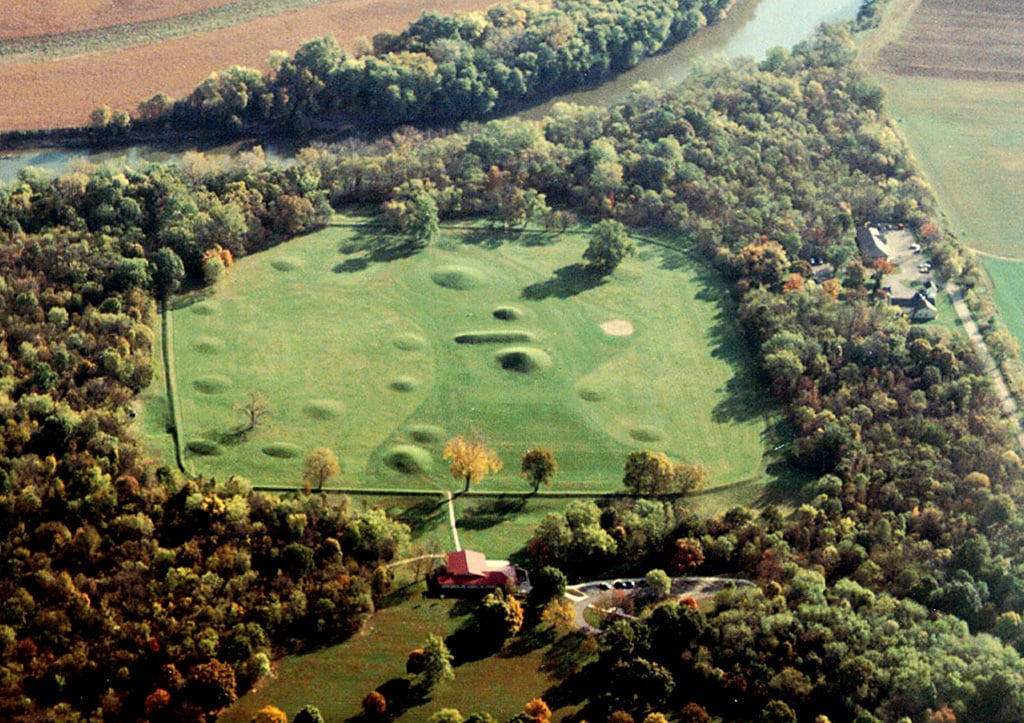
A golf course that sits on top of Native American earthworks in Ohio will be removed and the site will be opened to the public for the first time in over a century following a legal settlement. Moundbuilders Country Club has reached an undisclosed financial agreement with Ohio History Connection that will allow the historical society to buy out the club’s long-term lease on the property.
The landscape is home to 2,000-year-old mounds known as the Octagon Earthworks. Last year, it was one of eight important earthworks in central Ohio known as the Hopewell Ceremonial Earthworks to be jointly given UNESCO World Heritage Site status, thanks to campaigning by History Connection, the National Park Service, and the U.S. Interior Department.
The earthworks consist of walls forming a 50-acre octagon and a 20-acre circle that were built by the Indigenous Hopewell Culture between 1 C.E. and 400 C.E. The historical society has described these mounds as, “part cathedral, part cemetery, and part astronomical observatory” and “the largest set of geometric earthen enclosures in the world.”
Aerial view of the Octagon Site. Courtesy of the Ohio History Connection.
In a 2022 ruling in favor of the History Connection, Ohio Supreme Court Justice Michael P. Donnelly declared that “the historical, archaeological and astronomical significance of the Octagon Earthworks is arguably equivalent to Stonehenge or Machu Picchu.”
Chief Glenna Wallace of the Eastern Shawnee Tribe of Oklahoma has played a particularly instrumental role in winning overdue recognition for the earthworks. The Shawnee were originally from Ohio before they were forcibly removed by the U.S. government in 1832.
“I had never, until about the last five or six years, heard my ancestors ever referred to as anything except savages,” she told Columbus Monthly earlier this year. The sophistication of the earthworks show that “they had to be geniuses, and they’ve never been presented that way.”
Wallace has spearheaded multiple efforts reclaim land in the state, including the inauguration of a new state park commemorating the former Shawnee town of Old Chillicothe. These sites have become important destinations for tribal members tracing their ancestral roots in Ohio.
Since 1910, the site has been occupied by Moundbuilders Country Club, a private member’s club that prevented public access to the mounds. The History Connection acquired the land in 1933 but continued leasing it to the club, last extending the lease in 1997 through to 2078.
The Mound City at Hopewell Ceremonial Earthworks in Ohio, a UNESCO World Heritage Site. Photo: John E. Hancock, ©Hopewell Culture NHP/U.S. National Park Service.
In 2018, however, History Connection launched a lengthy legal battle when it sued to take over, citing the historical and cultural import of the mounds. The case worked its way up to the Ohio Supreme Court where, in December 2022, Donnelly ruled in favor of History Connection. The country club tried and failed to appeal his decision before agreeing to give up its lease for the right price.
At one point, the club asked for $12 million, according to the New York Times. The value of the club’s lease was set to be decided by a jury trial but, as it approached, both parties escalated negotiations in an attempt to reach a settlement out of court. The financial agreement has not been made public but the country club already has plans to acquire the nearby Trout Club, a resort with many attractive facilities including a golf course. This deal has not been finalized.
“The six years of litigation were driven by the club’s desire to be able to recreate itself at another location,” said David Kratoville, president president of the club’s board of trustees. “It was only in the last few months that the Ohio History Connection finally offered enough money for that to become a possibility.”
He added: “The members of Moundbuilders Country Club wanted to remain on the property that they were good stewards of for 114 years. We leave behind a clubhouse, Olympic pool, tennis courts and a one-of-a-kind golf course that we built over those years. The membership, a number of whom are second or third generation members, are deeply saddened.”
A rendering of the earthworks site when it was constructed. Courtesy of University of Cincinnati’s Center for the Electronic Reconstruction of Historical and Archaeological Sites.
Meanwhile, the 134-acre site containing the Octagon Earthworks will open to the public on January 1, 2025. Ohio History Connection’s executive director Megan Wood said, “we look forward to partnering with the community to bring vibrant and meaningful visitor experiences to this remarkable place, and we plan to provide more details after we officially take possession of the leasehold for the property.”
In response to this latest development, Wallace told the NYT that she is “ecstatic.”
“I’m trying to imagine how my ancestors must feel after all these years,” she said. “I look forward to being able to have people from all over the world come and enjoy that place. I hope we are able to maintain the cultural significance of it, and that people are able to realize how magnificent and intelligent the ancestors who built these wonderful earthworks were.”
The Eastern Shawnee Tribe of Oklahoma has also been reached for further comment.
The UNESCO designation covers the Fort Ancient Earthworks in Warren County, five sites that are part of Hopewell Culture National Historical Park in Ross County, and the Newark Earthworks, which include the Wright Earthworks, the Great Circle Earthworks, and the Octagon Earthworks. (The Newark Earthworks are also Ohio’s official prehistoric monument.)